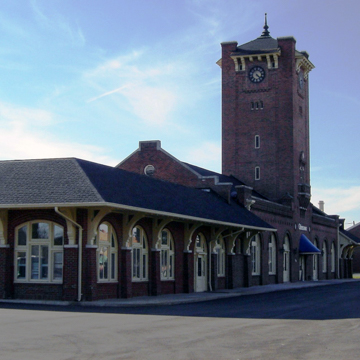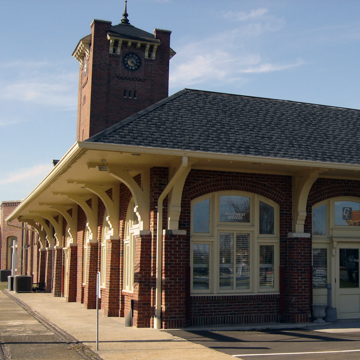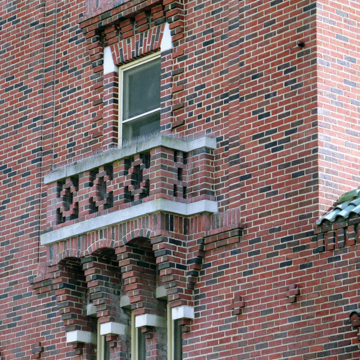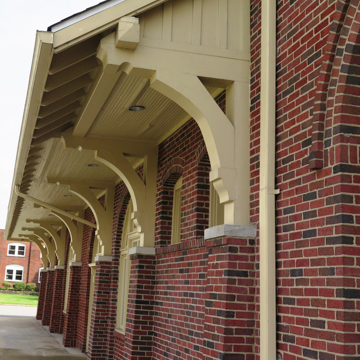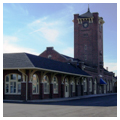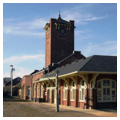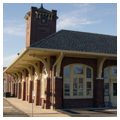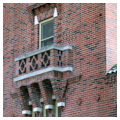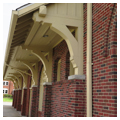You are here
Clinchfield Railroad Station
The Clinchfield Railroad Station was one of several buildings New York-based architect Clinton Mackenzie designed for the planned city of Kingsport, Tennessee. Inspired by both the City Beautiful and New South movements, the city of Kingsport changed the landscape of Sullivan County. The railroad station is the best representation of industrial New South Kingsport. Built in 1916 at the southwest end of Broad Street, the city’s main artery, the eclectic building with its imposing clock tower was intended to serve as a focal point for the business district and as a symbol of the town’s emerging industrial economy and its prosperity.
In its earliest days the Kingsport’s economy depended largely on commerce generated by its location on the Great Road between Nashville and Washington, D.C., as well as its position as the farthest upstream point from which flatboats could be launched on the Holston River. When steamboats and railroads replaced flatboats and long-distance road transportation, Kingsport became isolated because the railroad built through eastern Tennessee in 1859 was routed well south of the town, and the Holston River was not navigable for steamboats. Combined with the effects of the Civil War, Kingsport went into steady decline. In 1908, however, the town’s fortunes revived when the Carolina, Clinchfield and Ohio Railroad (CC&O) connected Kingsport with Virginia’s coal deposits. Kingsport became an industrial center and experienced rapid growth between 1910 and 1915. Building on this growth, John B. Dennis and J. Fred Johnson established the Kingsport Improvement Company in 1915, resulting in what Margaret Wolfe has identified as “the first thoroughly diversified, professionally planned, and privately financed city in twentieth-century America.”
The landscape architecture firm of John Nolen in Cambridge, Massachusetts, is given the most credit for designing and building the planned city, but many firms and individuals were involved. Landscape architect Earl S. Draper, still an employee of Nolen when he began to work on Kingsport, is perhaps most responsible for the overall design. Draper later headed the Tennessee Valley Authority’s Division of Land Planning and Housing. Draper hired Clinton Mackenzie to serve as principal architect for the new town. Mackenzie was a director of the National Housing Association and Tenement House Commissioner for the State of New Jersey. He was deeply committed to town plans that accommodated the needs of the working classes. Employing a mixture of period revival styles and elements of the Arts and Crafts movement, Mackenzie designed much of the housing and commercial architecture throughout Kingsport, including the Kingsport Inn, the YMCA, and a clubhouse for the Federal Chemical Company. Mackenzie also designed a never executed “separate-but-equal” satellite community for African Americans to be called “Negro Village.”
For the Clinchfield Railroad Station, the focus of the new town, he fused several styles notably the Beaux-Arts, Italianate, and Colonial Revival. The result is a rectangular, one-story, red-brick building with a central clock tower articulated with four chimney-like masses at the corners and, at the top, bold Italianate brackets supporting a pyramidal roof. Most of the brickwork is laid in stretcher bond, but the indented central bay of each side of the tower is laid in Flemish bond. The building has corbelled brickwork between arched openings and the roof and on the tower. But for a few of the windows in the tower, all windows and doors are arched. There is a portico at the northwest end. The central portion of the building has a gable roof; mansard roofs cover the southeast wing of the building as well as the portico at the northwest end. The eaves are supported by large knee brackets. There is a small brick balcony supported by brick corbelling below one of the facade windows on the tower.
In addition to regular passenger service, the Clinchfield Railroad Station has been used as a community venue, especially the Santa Train, which has delivered donated gifts along 110 miles of the rail line since 1943. Rail passenger service through Kingsport ended in 1954 and for a time the station was vacant. In 1995 the property was purchased by a locally-owned bank. With the help of preservation tax incentives, the station began a new life as the “Kingsport Train Station” branch of Citizens Bank.
References
Beasley, Ellen, “Clinchfield Railroad Station,” Sullivan County, Tennessee. National Register of Historic Places Nomination Form, 1973. National Park Service, U. S. Department of the Interior, Washington, DC.
Mackenzie, Clinton. Industrial Housing.New York: Knickerbocker Press, 1920.
Nolen, John, and Warren, Charles Davock. New Towns for Old: Achievements in Civic Improvement in Some American Small Towns and Neighborhoods. Amherst: University of Massachusetts Press, 1927.
Spoden, Muriel Clark. Historic Sites of Sullivan County. Kingsport, TN: Kingsport, 1976.
Tennis, Joe. Sullivan County. Charleston, SC: Arcadia, 2008.
Wolfe, Margaret Ripley. Kingsport, Tennessee: A Planned American City. Lexington: University of Kentucky, 1987.
Writing Credits
If SAH Archipedia has been useful to you, please consider supporting it.
SAH Archipedia tells the story of the United States through its buildings, landscapes, and cities. This freely available resource empowers the public with authoritative knowledge that deepens their understanding and appreciation of the built environment. But the Society of Architectural Historians, which created SAH Archipedia with University of Virginia Press, needs your support to maintain the high-caliber research, writing, photography, cartography, editing, design, and programming that make SAH Archipedia a trusted online resource available to all who value the history of place, heritage tourism, and learning.














